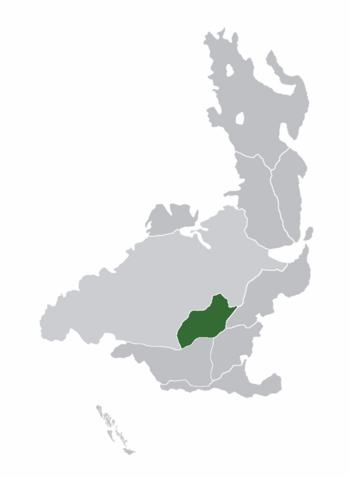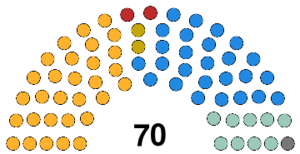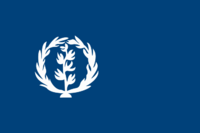Difference between revisions of "Uulgadzar"
m (→Union of Uul: add main) |
|||
| Line 105: | Line 105: | ||
=== Union of Uul === | === Union of Uul === | ||
| + | {{Main|Union of Uul}} | ||
=== First Mountain War === | === First Mountain War === | ||
Revision as of 14:52, 6 August 2023
Uulgadzar Republic | |
|---|---|
Motto: Бид хаана байх, бид явах Bid khaana baikh, bid yavakh "Where we stay, we go" | |
Anthem: Уулгазар улсын төрийн дуулал Uulgadzar ulsyn töriin duulal "National Anthem of Uulgadzar" | |
 Location of Uulgadzar in Ostlandet | |
| Capital and largest city | Uulhot |
| Official languages | Uulgadzan |
| Recognised national languages | Stepadnó |
| Ethnic groups (2020) | 82% Uulgadzan 16% Stepadnó 2% Other |
| Religion (2020) | 67.9% Ariunxavč 16.1% Christian 9% Atheist/Agnostic/No religion 7% Other |
| Demonym(s) | Uulgadzan |
| Government | Devolved unitary semi-presidential republic |
• President | Position vacant |
• Prime Minister | Solongo Jurchedei |
| Legislature | Ardbayshin |
| Formed by union of various tribes | |
• Formation of Union of Uul | 670 CE |
• Mountain War | 1593 |
• Silent Coup | 1978 |
• Proclamation of Uulgadzar Republic | 1978 |
| Area | |
• Total | 541,902 sq mi (1,403,520 km2) |
| Population | |
• 2022 estimate | 5,100,026 |
• 2020 census | 4,926,306 |
• Density | 9.09/sq mi (3.5/km2) |
| GDP (nominal) | 2020 estimate |
• Total | ₵65,315,300,000 |
• Per capita | ₵13,258.47 |
| Gini (2020) | 39.8 medium |
| HDI (2020) | high |
| Currency | Uulgadzan tögrög (UUT) |
| Time zone | AMT+11 (UGT) |
| Mains electricity | 120 V-60 Hz |
| Driving side | right |
| Calling code | +77 |
| ISO 3166 code | UU |
| Internet TLD | .uu |
Uulgadzar (Uulgadzan: Уулгазар [ʊʊɮɡatsar]), officially the Uulgadzar Republic (Uulgadzan: Бүгд Найрамдах Уулгазар Улс [pukt nɛːramtax ʊʊɮɡatsar ʊɮs]) is a land-locked devolved unitary semi-presidential republic in Ostlandet. It is bordered by Estcharia to the west, Mediternia to the northwest, Zloveshchiy to the east, Gjorka to the southeast, and Ajakanistan to the south. It is well-known for its sprawling steppe and "shining" mountains. Uulgadzar has a land area of TBD. Its total population, according to the 2020 census, is 4,926,306. Its capital and largest city is Uulhot.
The Uulgadzan people first arrived in the area of modern Uulgadzar in about 4000 BCE. Permanent settlements first began in about 400 CE, with the first united nation of Uulgadzan people being formed in around 670 CE, being named the Union of Uul. In 1593, the Mountain Wars erupted between the Uulgadzan Kingdom and TBD. After the Mountain Wars, the borders of Uulgadzar remained mostly unchanged for the rest of its history. In 1978, the Silent Coup abolished the monarchy and created a more open democracy in Uulgadzar. In 1979, the Uulgadzar Republic was formed.
Since 1990 the quality of life and quality of education in Uulgadzar has improved. A study in 2011 showed that the average Uulgadzan person would receive 3 more years of education in 2010 than they would have in 1990. The percentage of college graduates in the nation rose from 19.5% in 1985 to 68.9% in 2015. The nation's main exports are minerals, particularly copper, gold, coal, and uranium. Recently, there have been investments into producing natural gas via coalbed methane extraction. It is a secular state, however most people in Uulgadzar follow a religion, according to the 2020 census.
Contents
Etymology
Uulgadzar (уулгазар) comes from uul (уул) meaning mountain and from gadzar/gazar (газар) meaning ground or land. The two words were separated formally until the 19th century, when the nation's name was changed from Uul Gadzar to Uulgadzar. However, informally the words had been united as early as the 17th century.
History
Prehistory
The ancient Uulgadzan people first arrived in the area that is now Uulgadzar in about 4000 BCE. Very little is known about these people. They were mostly nomadic and domesticated horses.
The first Stepadnó people arrived in the area that is now east Uulgadzar around 2500 BCE. Ancient cave drawings from the area the Stepadnó were believed to inhabit show some people- most likely Uulgadzans- attacking their primitive villages.
Tribal era
It is believed that some ancient Uulgadzan groups settled down around 1000 BCE, during the advent of writing in Uulgadzar. Most of these settlements have been lost to time, however some buildings have been excavated and some of these villages have lasted through time, like the now-capital of Uulgadzar, Uulhot.
During the tribal era, the first large-scale structures were created as religious buildings. One of the largest structures was discovered near Altanövs in 1964 during an archaeology expedition where one of the locals reported a building sticking out of the ground after a drought. The structure is believed to be a building dedicated to Naršoroo.
During the late tribal era, around 300-600 CE, it is believed that the first skirmishes between the Uulgadzan people and the Stepadnó erupted. It is also believed that the raids on Stepadnó villages ended around this time.
Union of Uul
First Mountain War
Southern Expansion
Second Mountain War
Uulgadzan Civil War
Communist rule
TBD (1978-2007)
1978 coup
2007 riots
Geography and Climate
Uulgadzar contains a mix of temperate, semi-arid, and arid climates. In the south and north-west, semi-arid steppe climate dominates, causing hot temperatures with little rain. In the west, the Dogšin Desert has a predominately arid climate, with temperatures rarely, if ever, reaching below freezing, and nearly no rain. It is the most sparsely populated place in Uulgadzar. In the east, a temperate climate exists. It is separated from the semi-arid and arid climates by the Uulgadzar Mountains.
Politics
Government
Uulgadzar is a devolved unitary semi-presidential republic under a de jure substantive democracy. The nation's president serves as the head of state and the prime minister as the head of government. The president is voted on directly by the people, and appoints a prime minister.
Legislature
The legislative branch of Uulgadzar operates on a unicameral parliament named the Ardbayshin. The parliament, consisting of 70 seats, has one seat for every district, as well as one seat for each of the eleven provinces. The last elections took place on March 27, 2023, so the next elections will take place on March 27, 2025.
 | |||||
|---|---|---|---|---|---|
| Party | Abbr | Ideology | Seats | ||
| Uulgadzar Forward | Social democracy | ||||
| Together Uulgadzar | Liberal conservatism | ||||
| Neg-gadzar | Fascism | ||||
| People's Community | Democratic socialism | ||||
| Democrats | Social liberalism | ||||
| Independent | N/A | ||||
Law and judicial system
The judicial branch of Uulgadzar contains the High Court of Uulgadzar and then the Provincial Courts, of which there is one in each province. The provinces are then divided into District Courts of which there are at least 5 in every province. The District Courts are not each one singular court, but a group of courts which manage cases in a local area.
If a District Court provides a verdict which is not satisfying to the party requesting the verdict or the defendant in a criminal case, they can appeal the verdict to a higher court. This pattern continues to the High Court. The Provincial Courts or the High Court can deny overseeing the appeal. In that case, the lower court will review the case with a new judge. After the new judge rules on the case, the new verdict is final. If the court accepts the case, it will go through the same process it did in the previous court to determine a new verdict and, in the Provincial Courts, can be appealed to the High Court. The High Court's verdict is final.
Foreign relations
Uulgadzar is a partner state of the Ostlandet Union and generally maintains amicable relations with most of Ostlandet. The government has established trade agreements with many countries, including Monsilva. Uulgadzar has not been involved in a war with a foreign nation for hundreds of years, and it generally holds a position of neutrality preventing itself from getting into any current wars.
Military
Uulgadzar's military is not very large, with only 0.5% of the nation's GDP being spent on the military. The nation generally believes that a large military is not necessary with its geographic position. It believes the mountains and large rivers that make up the majority of the country will repel any potential invasions. In recent years, however, military spending has risen and a bill was passed in November of 2022 to expand military spending from 0.5% to 2% over 5 years. When questioned, no reason was given by government officials for the change, however it is believed the change occurred due to the rapidly destabilizing situation in Ajakanistan at the time.
Administrative divisions
Economy
Economic activity in Uulgadzar has, for most of history, been based on agricultural sources like wheat, maize, and livestock. However, starting in the late 19th century, coal, and, to a lesser extent, iron, copper, tin, and gold, have created a strong mining sector in Uulgadzar. Besides agriculture and mining, dominant industries in Uulgadzar include manufacturing, real estate, and transportation and storage.
Agriculture
Agriculture makes up about 20% of Uulgadzar's annual gross domestic product. However, the high altitude, extreme temperature fluctuation, and low precipitation make it unsuitable for most cultivation. The agricultural sector, therefore, is more focused on animal husbandry, both nomadic and stationary. In 2015, about 80% of land in the country was allocated to agriculture, with the vast majority used by nomadic animal breeders.
Crops produced in Uulgadzar include wheat, maize, and potatoes. Animals raised commercially in Uulgadzar include horses, sheep, cattle, and goats. These animals are raised primarily for the meat they produce, however goats are valued for their hair which can be used to produce cashmere wool.
Mining
Mining represented about half of the government's income in 2015. It represented nearly 85% of exports in 2010 and rose to nearly 90% in 2015. Most mining operations are overseen by one of the many state-owned mining corporations. Every year, there is an average of five new major mining operations started. Mining employs two-thirds of Uulgadzar's workforce.




